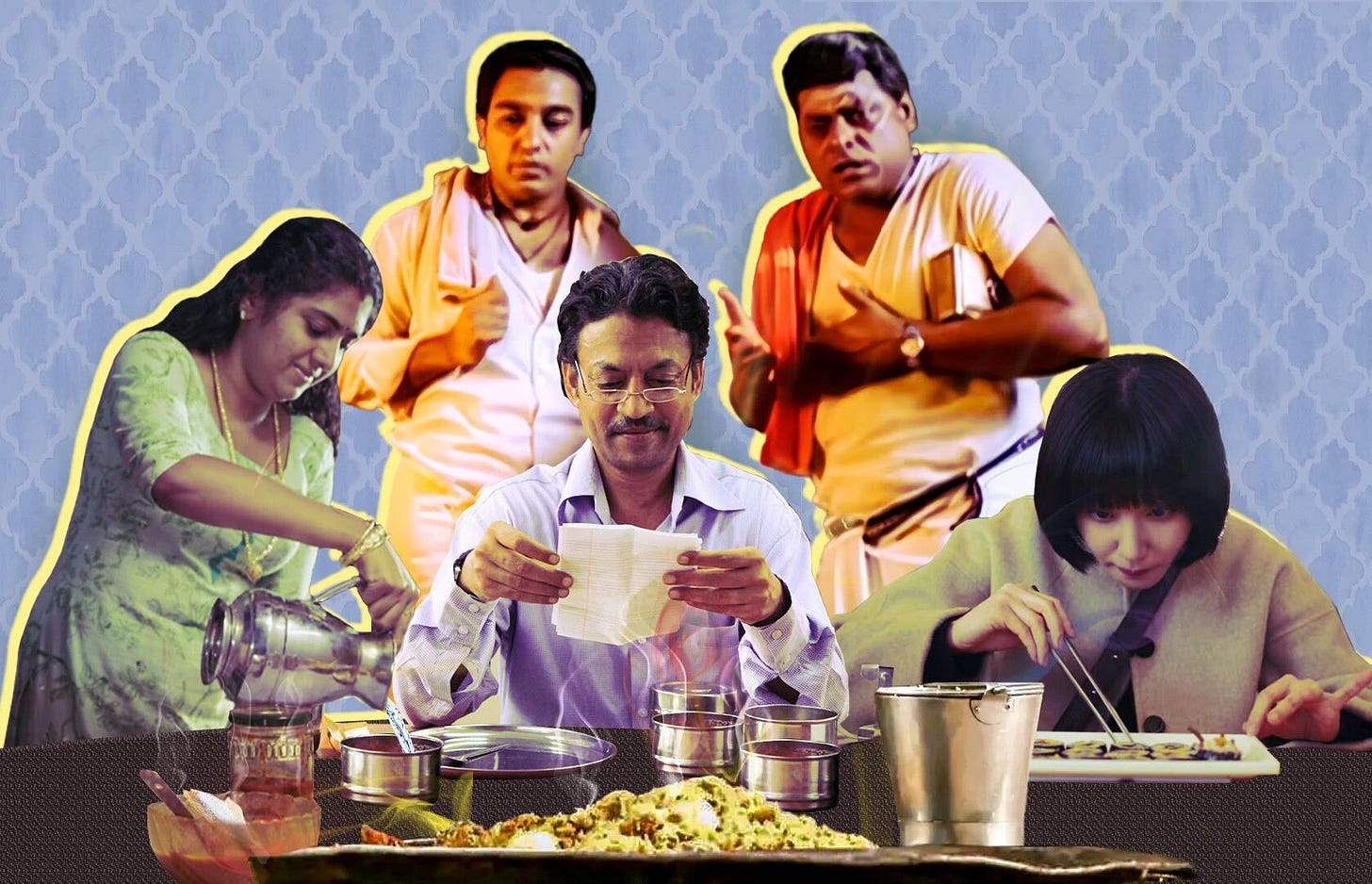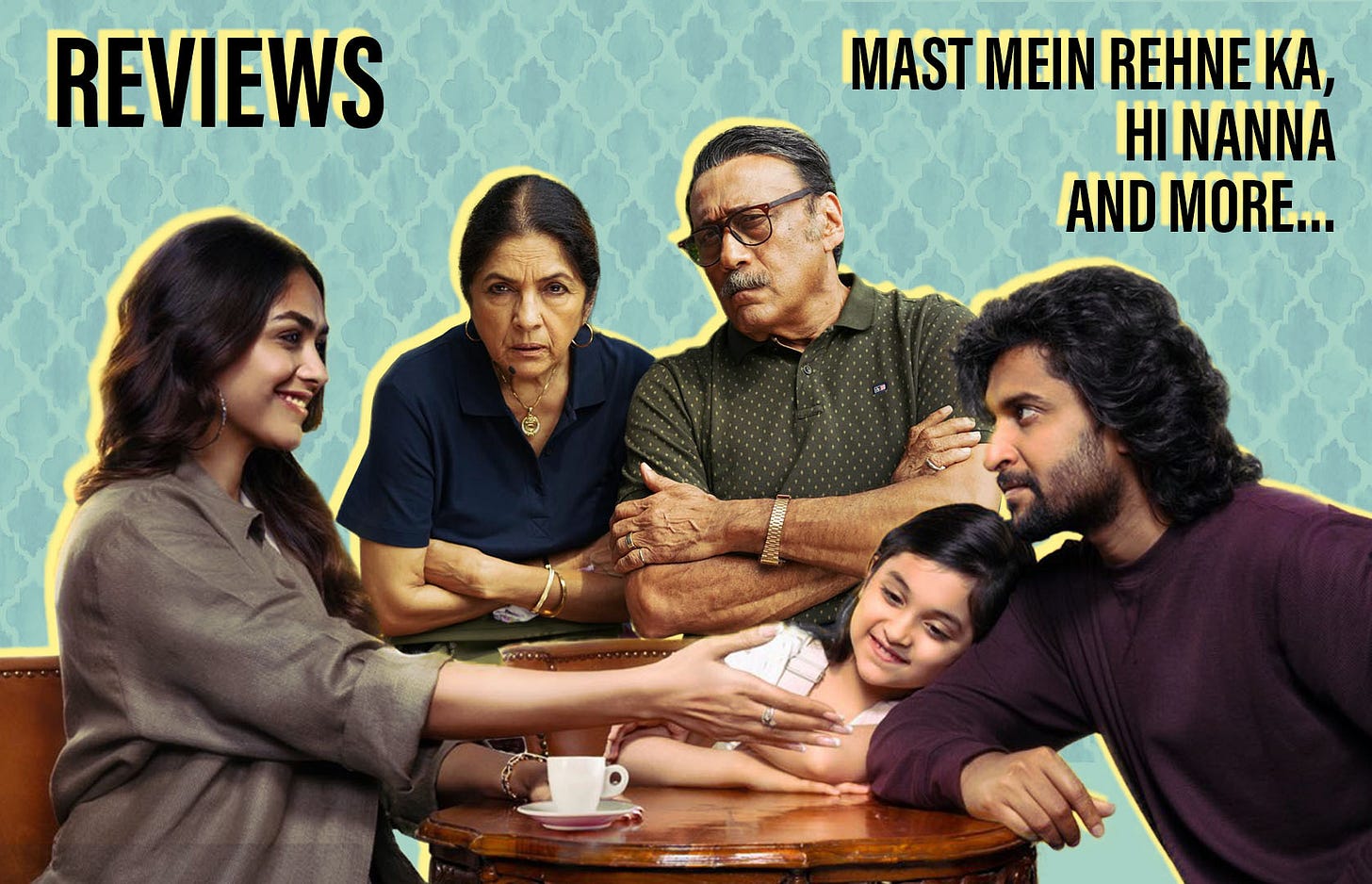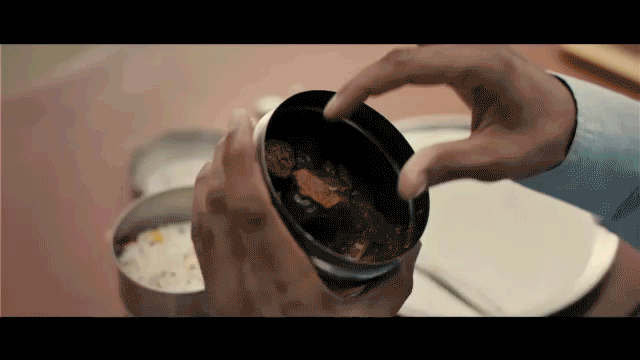Dear Reader, I suppose it was just yesterday or the day before you were scrolling through Netflix to find the right show or film to watch as you munch something for brunch (or dinner). If you weren’t already in the middle of binge-watching a show, I am sure you finished eating before you finally, half-heartedly chose something to watch. But what’s this strange connection between food and cinema? Let’s dig in.

The dining table is where food and conversations meet — from political talks and life tips to a lot of catching up. So, as we are already here to talk about food and cinema, let’s also peek in at some dining table conversations in films 👀.
In the Tamil film KD, the passion with which an old man delightfully devours the biryani slowly makes other customers do the same, so much so that the seller begins to pay him a commission to eat at his hotel every day. Food cravings while watching a film or show, especially about food are so real. For instance, do you know that Woo Young-woo fondly eating kimbap (seaweed rice rolls) in the Netflix series Extraordinary Attorney Woo actually boosted the global sales of the Korean dish?
An equally powerful connection is between food and memories. The taste or smell of a meal does take us back in time. For instance, Mohinga, Atho, Bejo and Khow suey are a few Burmese foods that are quite popular in Tamil Nadu. It’s not just because Tamil people may’ve tasted the food but because it’s Vijay’s favourite food in Nanban. Even after Vijay’s Pari and Ileana’s Ria go separate ways, the latter continues to eat Burmese food regularly; a sign that she never really moved on. There is a lot that changes over the years that we may realise if we only take a closer look at our food or eating habits. In another Tamil film, April Madhathil, a group of friends hang out together, when the protagonist’s brother visits them. Everyone eats their noodles, pasta and sandwiches using forks. However, the brother is hesitant. The protagonist is from a rural background but he is slowly accustomed to the ways of modern eating that he doesn’t even realise what his brother is struggling with. Only when the female lead notices this and begins to eat using her hands, do the friends realise the situation.
A dining table at a house is like a silent observer that has seen it all — the happy memories and the ugly talks. It also brings out the biases that exist in the family. In English Vinglish, the family belittling Shashi is quite evident the first time we see them together in the dining room, as they complain and mock her. But her feelings are laid out for us to understand much later, at night, when her husband tells her that it was the right thing he skipped the business dinner and came home to eat her tasty food. She sadly asks, “If my cooking wasn’t this good, you would never come home, right?” This conversation brings to mind the dining table in The Great Indian Kitchen where we always see the woman only serving and the one in Varisu, where the mother ensures everyone had their food but not a single person asks her if she ate.
In Reply 1988, a Korean series, the lead protagonist is a middle child who never gets the fried egg or the chicken legs when the family eats together because almost always there are only two pieces available, which her siblings get. But it’s also in the same series, she makes her friend feel at home by cooking him food when they are away in a foreign country for his business purposes. Isn’t it magical how food takes us closer to something we love even when we are miles away from it?
That magic is why dining tables witness beautiful events too. In the Telugu film Pelli Chupulu, the father realises the passion and potential of his son (who aspires to be a chef) only after he is made to eat a food made using his recipe. In A Little Thing Called First Love, a Korean series, a young man accepting his step-father and brother is shown by him joining them for dinner for the first time. Food, in itself, then becomes a language which conveys things that otherwise go unsaid. We talk a lot about the cafe in the Friends sitcom, but do we ever hark back to how much the dining table means to them? One that has seen multiple Thanksgiving dinners, Rachel’s messed up English Trifle, the burnt turkey and the uncountable conversations and love they share. In fact, some of the best food memories in cinema would be all those times when Monica cooks for her friends and when Joey, who says he doesn’t share food, fondly gives his sandwich to Chandler. ~ Harshini
This Week in Reviews
Hi Nanna - The film has a heart of gold that compels you to look beyond its predictability issues. The final 30 minutes are just 💙.
Mast Mein Rehne Ka - Jackie Shroff, Neena Gupta and Rakhi Sawant star in a delightful ode to Mumbai.
Kadak Singh - An oversmart psychological thriller with Pankaj Tripathi, and Parvathy.
Extra Ordinary Man - Vakkantham Vamsi's film tries to carefully tread the line between absurdity and playfulness but the result is a hit-and-miss.
Chamak Series - The USP of Chamak is that it has an expansive 28-song soundtrack – spanning rap, folk, pop and classical by Punjabi artists past and present – but the storytelling fails to transcend its glorified music-video vibe.
Kastoori - A coming-of-age story with heart and idealism.
Wonka - Timothée Chalamet is simply scrumdiddlyumptious.
Joram - A gripping social drama disguised as a survival thriller.
Food Films That’ll Make You Want To Cook
What is it about food in films that makes it so uniquely memorable? I’ve watched my share of films — with particular attention to detail ever since film class in college — and I can say with assurance that I’ve never seen a dish on screen that I’ve forgotten. It doesn’t even essentially have to be a food film (of course who can ever forget the decadent grilled cheese that Jon Favreau whips up in Chef or the ratatouille that makes Ego and me tear up every time in unison). It can be the 5-minute biryani that Pandiaraj rustles up in a lift in the Tamil film Gopala Gopala or the nei murukku that Vikram cherishes in Sethu, food has always had a hold on me (I’m sure like many others) not only IRL, but also in films. In this draft though, let’s take a look at a different kind of food film — films that not only celebrate food but also do so with an emotional and meticulous approach. Here are four such reccos that span across cuisines.
Lunchbox
Ila and Saajan’s slow yet luminous blooming of friendship over dabbas of dal, subzi and roti can make any person hungry. But that’s not just why Lunchbox is special. Ritesh Batra’s film doesn’t just move through the fully prepared and obviously delicious koftas and dals, but stops to show us the odd chutkis of masala that changes the game or the paneer that’s meticulously shredded before it can become a glorious gravy. The film has a certain rhythm to it that not only makes us hungry, but also makes us want to cook.
Julie and Julia
I cannot tell you the number of times I’ve watched Julie and Julia and been immediately washed over by the desire to do my own food challenge. While that has certainly never once happened — if we aren’t counting the odd Insta documentation of my experiments in my tiny Bangalore kitchen — every time I watch Julie fuss over her boeuf bourguignon or make those ugly delicious soufflés sucrés, I momentarily get to live the life of a happy home-cook trying her best to master the art of French cooking. And that’s enough for now.
Eat Drink Man Woman
The opening scene of Ang Lee’s Eat Drink Man Woman alone can make any viewer want to take an immersive tutorial on Chinese cooking (Beggar’s chicken or mutton hotpot, anyone?) or in the least, come close to Lung Sihung in cutting onions. In this comedy-drama, a world-renowned chef in Taiwan, learns more and more about his daughters and himself over elaborately prepared Sunday feasts at home, even as he battles the loss of his wife and suddenly, his taste.
PS: If you want to experience a similar vibe, but be transported to Europe instead, do watch the Danish film Babette’s Feast.
Spirited Away
Studio Ghibli films always have a way with food. We all know that Hayao Miyazaki can make hyper-real evocative animation that often makes us want to jump into the screen and cohabitate in his universe. This is because of his tendency to include the smallest of things that make life unique. And possibly the best way he does this is with food. While Spirited Away, like My Friend Totoro, might not have expansive shots of food preparations and what it means, food still shows up in its most important scenes. Whether it’s that first bite of a rice ball that makes Chihiro bawl at her experience with loneliness or the red-bean bao that establishes the comfort of a new friendship, Spirited Away made me look at food and cooking in a way that not many films have. ~ Sruthi Ganapathy Raman








